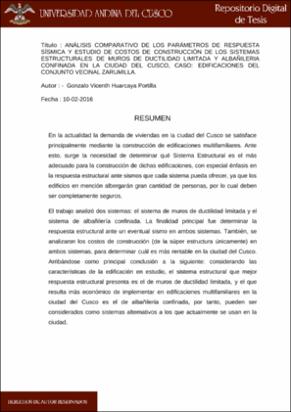| dc.contributor.advisor | Gudiel Cárdenas, Mitsy Elena | |
| dc.contributor.author | Huarcaya Portilla, Gonzalo Vicenth | |
| dc.date.accessioned | 2016-06-21T15:39:09Z | |
| dc.date.available | 2016-06-21T15:39:09Z | |
| dc.date.issued | 2016-02-16 | |
| dc.identifier.uri | https://hdl.handle.net/20.500.12557/86 | |
| dc.description.abstract | En la actualidad la demanda de viviendas en la ciudad del Cusco se satisface principalmente mediante la construcción de edificaciones multifamiliares. Ante esto, surge la necesidad de determinar qué Sistema Estructural es el más adecuado para la construcción de dichas edificaciones, con especial énfasis en la respuesta estructural ante sismos que cada sistema pueda ofrecer, ya que los edificios en mención albergarán gran cantidad de personas, por lo cual deben ser completamente seguros.
El trabajo analizó dos sistemas: el sistema de muros de ductilidad limitada y el sistema de albañilería confinada. La finalidad principal fue determinar la respuesta estructural ante un eventual sismo en ambos sistemas. También, se analizaron los costos de construcción (de la súper estructura únicamente) en ambos sistemas, para determinar cuál es más rentable en la ciudad del Cusco. Arribándose como principal conclusión a la siguiente: considerando las características de la edificación en estudio, el sistema estructural que mejor respuesta estructural presenta es el de muros de ductilidad limitada, y el que resulta más económico de implementar en edificaciones multifamiliares en la ciudad del Cusco es el de albañilería confinada, por tanto, pueden ser considerados como sistemas alternativos a los que actualmente se usan en la ciudad. | es_PE |
| dc.description.abstract | Nowadays, the demand for housing in Cusco city is mainly satisfied by
the construction of multifamily buildings. Given this, there is a need to
determine what structural system is best suited for the construction of these
buildings, with special emphasis on the structural response to
earthquakes that each system has to offer, as the buildings in question will
house large numbers of people, they should be completely safe.
The study analyzed two systems: the limited ductility walls system and
the confined masonry system. The main purpose was to determine the
structural response to a possible earthquake in both systems.
construction costs (of the superstructure only) were also analyzed in both
systems, to determine which is more profitable in the city of Cusco. Arriving
to this main conclusion: Considering the characteristics of the building under
study, the structural system that has the best structural response is the
limited ductility walls system, and the less costly to implement in
multifamily buildings in Cusco city is the confined masonry system,
therefore both can be considered as alternative systems to those currently used in the city. | en_US |
| dc.description.uri | Tesis | es_PE |
| dc.format | application/pdf | es_PE |
| dc.language.iso | spa | es_PE |
| dc.publisher | Universidad Andina del Cusco | es_PE |
| dc.rights | info:eu-repo/semantics/restrictedAccess | es_PE |
| dc.source | Universidad Andina del Cusco | es_PE |
| dc.source | Repositorio Institucional - UAC | es_PE |
| dc.subject | Construcción | es_PE |
| dc.subject | Muros | es_PE |
| dc.subject | Edificación | es_PE |
| dc.subject | Parámetros | es_PE |
| dc.title | Análisis comparativo de los parámetros de respuesta sísmica y estudio de costos de construcción de los sistemas estructurales de muros de ductibilidad limitada y albañilería confinada en la ciudad del Cusco, caso: edificaciones del conjunto vecinal Zarumilla. | es_PE |
| dc.type | info:eu-repo/semantics/bachelorThesis | es_PE |
| thesis.degree.name | Ingeniero Civil | es_PE |
| thesis.degree.grantor | Universidad Andina del Cusco. Facultad de Ingeniería y Arquitectura | es_PE |
| thesis.degree.level | Título Profesional | es_PE |
| thesis.degree.discipline | Ingeniería Civil | es_PE |

